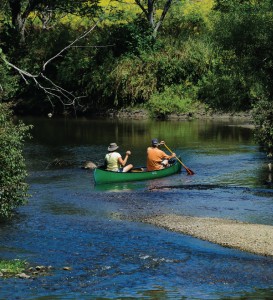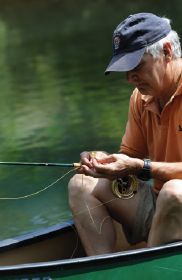 It was a good day to be outside, coming after a long string of days that had been decidedly the other kind. Vermont weather is like that and it is hard to know what kind of day you will be getting until you get it. For this reason, we didn’t have anything planned. The day was a gift so we decided to surprise ourselves.
It was a good day to be outside, coming after a long string of days that had been decidedly the other kind. Vermont weather is like that and it is hard to know what kind of day you will be getting until you get it. For this reason, we didn’t have anything planned. The day was a gift so we decided to surprise ourselves.
“Let’s take a float trip,” I said.
“When?” Marsha said.
“Today,” I said. “Right now.”
“We don’t have time for that,” she said and explained that we had dinner plans. Canoe trips had, over the years, become sort of an expeditionary thing for us and we didn’t just pick up and go. We planned. We studied maps. We made check lists. Shopped. Then we went off to the Adirondacks or to Maine and were gone for a week or more.
A float trip was not the sort of thing you did spontaneously, just because the weather was nice.
“We’ll be back in plenty of time,” I said.
She gave me a skeptical look. “And where would we be going on this float trip?”
“I’m thinking we should go paddling on the longest river in Vermont,” I said.
“Which is?”
“Otter Creek, of course.” An hour later, we were pulling out of the driveway with the canoe and a hastily made lunch.
The confusions of Otter Creek do not end with the name. How can the state’s longest “river” be called a “creek”? Beats me. But, then, how can a river in the northern hemisphere flow north? There are some notable rivers that do. Not least the St. Lawrence. And, then, there is the St. Johns in Florida. And, of course, the Nile. But mostly we expect our rivers to flow south, especially when they are modest streams like Otter Creek, which is a mere one hundred and twelve miles long and never rises to the kind of size and grandeur that would demand it be called a “river.” For most of its length, it looks like a creek. Certainly, you would not be insulting the stream to call it that.
From Middlebury to Ferrisburg, where it empties into Lake Champlain, Otter Creek is accessible and extensively paddled by canoes and kayaks. Back in the early days of European settlement, the stream was considered strategic enough at its mouth to be fortified. There was even some shipbuilding done there. And there were dams thrown across the stream at various points. The only dam building that goes on these days is done by beavers and this was something we had to consider in our planning—such as it was. We would be paddling Otter Creek close to the stream’s source near Mt. Tabor where you can step across it with ease. This stretch of Otter Creek flows near the town of Danby on the eastern side of Route 7, from which you can catch a glimpse of the stream, now and then. But mostly it is hidden from view by the thick growth of alders along its banks.
Most of the water we would be paddling flows through the Otter Creek Wildlife Management Area which consists of slightly more than a thousand acres, divided into three parcels. It is open to the public for fishing, hunting, trapping and, though the literature does not specifically mention it, goofing around in a canoe on a nice day.
We did some reconnaissance and found two or three possible places to put in. Some easier than others. We checked them out and took the one furthest downstream since that would make it less likely we would run into one industriously engineered beaver dam after another and spend the day dragging the canoe over them. This put-in was near an old bridge that can be accessed down a two track. There is an iron gate across the two-track but no lock and no signs warning that trespassers would be dealt with by a drone strike. We closed the gate behind us and parked in a wide pullout so as not to block the road. After that, it was about a fifty-yard carry and drag to get the canoe to the water.
We loaded paddles and safety cushions, lunch and fly rod, camera and sun screen … all the essential for a leisurely float down the low country. Which, come to think of it, is a much-neglected feature of the Vermont terrain.
This is, no doubt, because we are proud of our mountains and love them so. With good cause. Like, I suspect, most people who live here, I look up at the mountains several times during the course of a day with feelings that border, sometimes, on reverence. Those mountains are not majestic like, for instance, the Rockies. But they get inside you, just the same. They have a weathered and worn look. An aspect of durability.
So we are the Green Mountain State. Not the Little, Meandering, Marshy North-Flowing Stream State. We sometimes do not even see wonders like the Otter Creek drainage because our eyes are drawn, inevitably, to the mountains.
But the low country has its charms and, because they are so often overlooked, you can experience them in solitude. If we had taken this bonus day as an opportunity for a hike on one of the nearby trails through the Green Mountain National Forest, we would have had plenty of company. That’s not a deal breaker, of course, but sometimes you like a little solitude.
Which we had when we put in on Otter Creek. We were alone but, plainly, other people had used the bank where we put in. For fishing, most likely. The anglers had left a fire ring of stone and some charred logs at a wide sandy spot on the bank.
The stream was relatively deep here. I watched for rising fish and saw none. So we started downstream. Slowly.
The recent rains had raised the stream’s water level so that even when we moved downstream from the deep fishing hole where we had put in, there was enough water to float the canoe. But not much more than that. If you dug your paddle in too deeply you would catch the bottom.
Still, we were on the water and moving with the flow, which is one of life’s more pleasurable, even consoling sensations. When you are on moving water, things are always changing. Which explains, I suppose, why your sense of time is altered when you are being carried downstream, on the current. Also, dreamy and pleasurable as the sensation of going with the flow might be, you feel need to be alert and engaged as you go downstream where, up ahead, there is always the prospect of coming upon something new.
Our first surprise came as we rounded a soft bend in the stream and jumped a pair of mergansers. They came off the water with their legs churning the surface of the river and labored downstream, along a straight, flat stretch of water, slowly gaining the speed and altitude they needed to get away from this sudden threat— us—that had appeared and so rudely disturbed the tranquility of their day.
They were beautiful to watch. Not nimble, like the various puddle ducks you can also jump along this stretch of the stream—mallards, pintails, teal—but impressive in their own, hard-working way.
A marsh like this one will be a gold mine for people whose passion is bird life, so the mergansers were just a beginning. The only bald eagle I have ever seen in this part of the world was in terrain not much different from the Otter Creek swamp we were padding. We did not see one that day but, then, would not have been much surprised if we had.
I look up at the mountains several times during the course of a day with feelings that border, sometimes, on reverence. Those mountains are not majestic like, for instance, the Rockies. But they get inside you, just the same. They have a weathered and worn look. An aspect of durability.
We did see an osprey and the shallow clear water in this section of the stream would be ideal for that bird’s purposes—namely, the hunting and killing of unsuspecting fish. We watched from a fair distance as the bird circled, seemed to hover, then folded its wings and dove. It disappeared behind the wall of alders and, then, after a moment or two reappeared. It was flying more ponderously, now, since it held a fish in its talons.
A little further downstream, we came across another large bird. A blue heron. It was standing on a sandbar, in water that was probably six inches deep, as immobile as if it had been carved out of stone. I’d seen some dace—two or three inches long—in the shallow water along the bank where we put in and suspect that is what the heron was hunting. But he would have settled for a fingerling trout or a frog or crawfish … even a snake. Pretty much anything that happened along. The heron is an indiscriminate eater, sort of like a Frenchman, that way. Which is appropriate since, in profile, the bird looks sort of French. And there was something undeniably haughty about the way this one gave us the eye as we came closer, then flew off with a loud squawk when we got inside his space.
We also saw kingfishers and a couple of hawks riding the wind. Saw and heard several songbirds. The marsh is full of them. I thought I might even have heard a grouse drumming on the higher ground, back from the stream’s banks. All in all, it was a good day for birds, which wasn’t surprising since, according to the literature, the marsh is habitat for more than 40 species.
We had our picnic on a stretch of sandy bank where we had beached the canoe. There were raccoon tracks in the sand. Also the prints left by deer that had, I suppose, come here to drink. You had the feeling, looking at those tracks, that this was a pretty busy place, especially at night.
I’d had a good afternoon on another stretch of the stream, a few years earlier. A friend and I got lucky with our timing and were on the water during a robust hatch of mayflies. We spent a couple of hours casting to rising fish and caught a lot of them. Small rainbows, all of them, though my partner lost one fish that he believed was a brown trout that had some size.
There was nothing hatching on this day. But the afternoon had warmed and there was the possibility of something falling into the river from the bank and floating downstream to where a fish was waiting. So I watched the little cutbanks for the splash of a trout taking a beetle or a grasshopper. I thought I saw something that might have been a rise so we pushed the canoe against the bank and I made a few casts to the spot.
It would have been nice to catch that fish—if, indeed, there was a fish— and have had it to augment our lunch. We had once, on another Vermont stream, caught three or four small rainbows and then prepared them au bleu over the flame of a small mountaineering stove that I carried in my pack. We’d lounged on the bank, eating trout and spring fiddleheads, which we’d cooked earlier over the stove, and enjoyed the goodness of life.
We didn’t need a fish for our lunch on this day and good thing, too, since I couldn’t persuade one to come to my fly. But we dined well, just the same. A package of smoked salmon and a hunk of Rupert Rising bread. Some locally produced goat cheese and some fruit. And, to wash it down, some agreeably cheap white wine, though it might have been more fitting if we had brought along a couple of bottles of Otter Creek Ale from the award winning brewery further downstream, in Middlebury.
We had our picnic on a stretch of sandy bank where we had beached the canoe. There were raccoon tracks in the sand. Also the prints left by deer that had, I suppose, come here to drink. You had the feeling, looking at those tracks, that this was a pretty busy place, especially at night.
But this was mid-afternoon, warm and bright, so there was no animal activity. I’d hoped, vaguely, to see an otter, one of nature’s more ebullient creatures. The stream is named for them, after all, and we were plainly in good habitat. But no otters and no beaver, either, but I checked that off in the plus column, since we hadn’t been obliged to drag our canoe over any beaver dams.
We reached a point on our downstream swing when it seemed like we had gone far enough. Somewhere short of a commercial campground which has stream access. We hadn’t seen any other people so far and it seemed like a good idea to keep it that way. Solitude had begun to seem like the whole point of this little excursion. So we turned around and paddled back upstream. It was easy enough. Almost like flat water.
But not quite. And we were back home in plenty of time for dinner. ◊
Geoffrey Norman is a Dorset author and a frequent contributor to STRATTON MAGAZINE.


